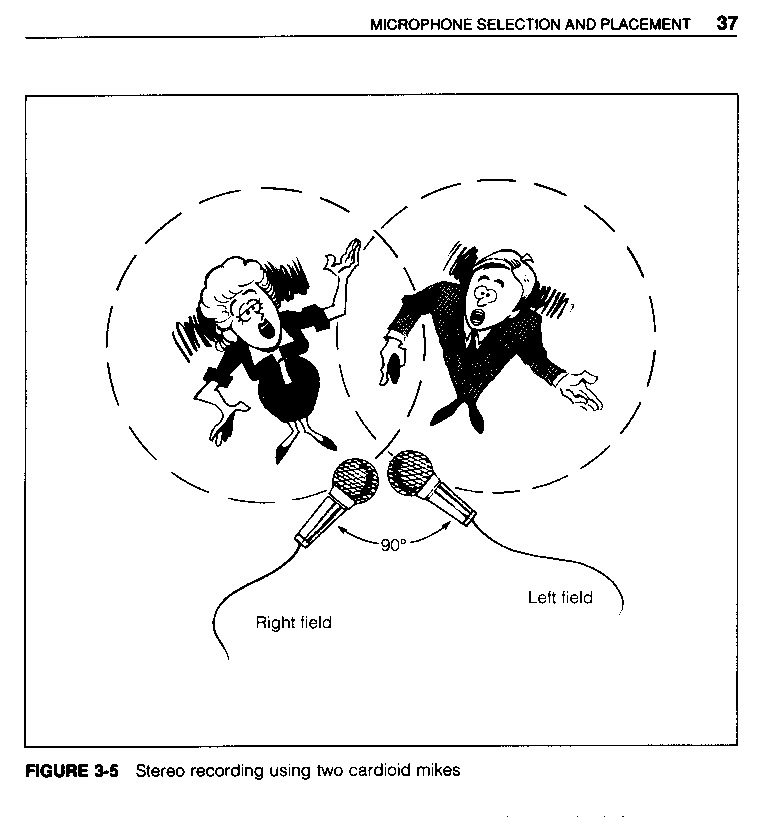
242
FIELD MIKES: GREAT AUDIO ON LOCATION

Welfare is said to make us lazy and unproductive. Tell
1. Keep your mike as close to your performer as possible.
Distance allows echo and background noise to mix with your desired
sound. Further, natural bass frequencies drop off quickly with
distance. Exception: recording a choir in a church. Here you
want the microphone to be near the group but not near a
particular member of the group who will dominate the sound.
Further, echoes in the room fortify the sound making it robust at
some distance.
2. Choose the right mike for the task. Take into consideration
whether the microphone needs to reject unwanted echoes and
background noise (ie. a directional microphone) or whether the
sound is coming from several directions at once, requiring an
omnidirectional microphone. For a person speaking, a tie clip or
lapel microphone is best. If wires are a problem, a wireless
mike may do. Or maybe a directional microphone on the end of a
fishpole can follow the performer or reach into a tree to catch
the hoot of an owl. Shotgun microphones are excellent for
rejecting extraneous noise, but may give unpredictable fidelity
depending on other surfaces near the performer.
3. Use balanced lines, the kind with three wires and XLR plugs
on the end. Unbalanced lines, one wire and a shield terminated
with a phone or RCA plug pick up hum and other electrical
interference easily, especially if the wires are longer than
eight feet. Balanced lines, on the other hand, cancel out
interference, transferring a clear and quiet signal over
distances of 30 feet and more.
4. Bring adaptors and transformers. You never know what you are
going to have to connect to what. Transformers will allow you to
interface unbalanced equipment (ie. consumer tape recorders, CD
players, and PA systems) with professional gear having XLR plugs.
Radio Shack sells balancing transformers (part #274-016 or
017) for about $13. Higher quality varieties are available from
professional audio distributors such as Shure of Evanston,
Illinois and cost about $45.
5. Also use ground lifters and pads. Audio ground lifters
permit your audio mixer to take a feed from someone else's mixer
or PA system without picking up hum.
Pads are resistors used in audio to reduce the strength of
a signal. The powerful audio from a public address system, for
instance, can be fed through a pad and reduced to a tiny voltage
appropriate for a mixer's microphone input.
Radio Shack sells pads or line attenuators (part number
274-300) for about $3.00.
6. Calibrate your VU meters. Send a test tone through your mixer
and turn its volume and master controls up to about half way and
look at your meter. Raise or lower both of them until the meter
reads 0 VU. Then send the signal to your recorder and adjust its
volume control to read 0 VU. Hopefully the VCR's control is not
near 0 or the maximum on its scale; if it is, you need
amplification or a pad, or maybe you've plugged the mixer's low
level output into the VCR's hi level input or vice versa.
7. Always bring high quality headphones (with muffs to seal out
ambient sound) and check the sound going into the mixer, and the
sound going into the recorder. If the sound is good in one place
and bad in another, at least you've narrowed down where to look
for the trouble.
8. Always play back a sample recording before the actual
recording begins, just to Murphy-proof your recording session.
9. If sound is being recorded separate from your video, place a
visual and audible cue before the beginning of the recording that
will permit the two to be easily synchronized. This is what
filmmakers and some videographers use the famous "clapper" for at
the beginning of each take. You can get the same result by
holding up several fingers then clapping your hands in front of
the camera.
10. Train your ear to listen for background sounds such as
motors, wind, fans, whirring disk drives, audio hum or buzzing,
buttons rattling against microphones, creaking mike cords,
chirping crickets, distance traffic or voices, or the beep beep
of wrist watches chiming out the hour. These sounds are much
easier to silence when recording than to filter them out while
editing.
11. Record sound. Shut everybody up and record a minute of
ambient background sound of the room, factory, party, or forest
where you happen to be recording. Not only can you use this as
filler between prepared audio segments, but it also serves as
nice background for voiceovers you might decide to add later.
12. Attempt to get the highest level signal possible without
distorting your sound. VU meters should ride consistently around
0 dB with occasional spikes going up into the "red" zone (+2, +4,
+6 dB). This assures that your source sound is much louder than
background hiss in your tape.
13. Use "manual" versus "auto" record levels. No machine can
make decisions as wisely as you. Use automatic only when you
don't have the fingers or time to twiddle the knobs.
Pickup Patterns -
This has nothing to do with how men introduce themselves to
ladies in bars. A microphone's pickup pattern describes how well
it listens in various directions.
An omnidirectional microphone listens equally in all
directions. You would use it to mike a crowd or a group of
singers. It works well on a podium if your performers tend to
move around or turn to the side while speaking, or lean forward
into the microphone. Tie-clip microphones are generally
omnidirectional, allowing the person's head to turn without
affecting the volume of the sound very much. They also pick up
chest vibrations to fortify the bass frequencies. Because
tie-clip mikes are so close to the performer's mouth, they tend
to pick up very little background sound.
A unidirectional microphone listens in one direction
primarily and rejects sounds from all other directions. A
shotgun microphone is useful when you need to pick one member out
of a crowd or one bird out of a tree (something my cats can do).
The shotgun microphone must always be aimed to be affective; if
the talent walks off axis, their voice will diminish abruptly.
Directional microphones exhibit the proximity affect; if you
get too close to the microphone, it boosts the bass in your voice
thunderously. It also emphasizes the letters b, p, and t which
sound like bombs bursting in air. Omnidirectional microphones
don't manifest this problem until you are about an inch from
them, but unidirectional microphones need to stay a foot or so
from the speaker to avoid consonant bombardment.
Part way between the omnidirectional and the unidirectional
microphone is the cardioid and hyper-cardioid microphone. Here
the pattern of sensitivity, if you graphed it, would be in the
shape of a heart, representing great sensitivity at the tip of
the heart (the direction the microphone is aiming), and almost no
sensitivity at the heart's cleavage, usually the handle of the
mike. Cardioids and their more directional brothers the
hyper-cardioids are somewhat sensitive to popping p's and b's,
and need to stay some distance from the speaker's lips to avoid
the proximity affect. They are good, however, at reducing
feedback, from PA systems where sound emanates from the speakers
and works its way back to the microphone causing a whoop, squeal
or ringing sound. Aiming the microphone and speakers away from
each other and increasing the distance between them also helps
diminish feedback. Omnidirectional microphones are most
sensitive to feedback.
Bi-directional or figure-8 microphones listen in two
directions, the front and the back and hardly at all from the
sides. They are used primarily in talk shows and certain stereo
applications.
Pressure zone microphones, or PZM's, have a hemispheric
pickup pattern listening omnidirectionally on one side of the
microphone and not at all on the other. You would typically
mount a PZM on a square of plexiglas or other flat surface. The
mike would pick up all sounds on one side of the surface and
ignore sounds on the other side. PZM mikes are often used on
boardroom tables to pickup the voices of people around the table.
The mike also tends to pick up the sounds of papers and pencils
rattling. If your guests like to fidget, ask them to do it with
their feet; the mike ignores sounds from its opposite side.
Mikes with parabolic reflectors are handy for strengthening
weak sounds such as woodland critters or distant outdoor
conversations. Bass fidelity is poor (unless the reflector is
huge) and the system easily picks up wind noise, as well as the
snorts or sniffs of the person aiming the mike.
Recording Stereo -
Naturally, you need a stereo camcorder or audio or video
recorder to record stereo. Most of these machines will have two
inputs marked CH1 and CH2 or L and R for the left and right
channels. Some consumer gear display one audio input that
accepts a stereo signal. The socket accepts a stereo plug that
looks a little like a stereo headphone plug having a tip, ring,
and sleeve construction. The tip carries one channel, the ring
the other channel, and the sleeve the ground. If you have a
stereo microphone with the proper plug, you are all set. If not,
you will have to acquire an adapter with separate monaural left
and right plugs at one end and the stereo plug at the other.
Incidentally, if you hookup only the left channel, many
camcorders and VCRs will switch to monaural and record the same
signal on both channels.
Note that if your tapes are played back through a garden
variety RF modulator, the kind built into VCRs, usually tuned to
channel 3 or 4, your stereo sound will turn monaural. This is
true even if your TV set is stereo. To maintain stereo from the
VCR to TV, you need to run the video and audio signals directly
or employ a professional stereo RF modulator.
Although there are stereo microphones with two transducers
built into the same body, most professional stereo recordings are
the product of two monaural mikes used independently. Typically
you set a pair of microphones in the shape of a cross pointing
one 45° to the left of center and the other 45° to the right of
center. The heads of the microphones should be only a few inches
apart to avoid accidental phase cancellation when the signal is
played back monoaurally. Professionals call this arrangement X-Y
or coincident pair miking.

Another stereo miking technique is M-S or mid-side. Here,
What is phase cancellation? Whenever two microphones (used
for stereo or not) pick up sound, and the mikes are any distance
apart, sound will reach one mike before it reaches the other.
Certain frequencies of sound will have waves that are at their
high point (compression of the air molecules) when they reach the
first mike, while the trough between the waves (rarefaction of
the air molecules) from the same sound is hitting the second
microphone. In other words, the first microphone is vibrating
inwards while the second one is vibrating outwards from the same
sound. The two signals combine and equal zero, ergo phase
cancellation. Your ear will hear a weak or hollow sound or a
flanging science fiction-like whoosh to the sound. Whenever
recording stereo, you must avoid phase cancelling situations, and
check your monaural mix to assure your program sounds good on
monaural TVs and public address systems.


A third type of microphone is the stereo zoom mike, found
Professionals using mixers or multi-track recorders are
likely to use more than two mikes in a technique called close
miking. Here each person or musical instrument gets its own mike
and the mike is close enough to the sound source to pickup
primarily that one sound. The sound engineer combines all the
sounds and using a pan pot on the mixer (live or during editing)
assigns that sound to the left or right channel or somewhere
inbetween.
Shotgunnery -
The little grooves and holes that decorate a shotgun
microphone's surface are not cosmetic but an integral part of its
sound control system. You should never cover them with your
hands, tape, or allow them to get clogged. If you do, the
microphone's directionality and sound fidelity will be severely
affected.
So how do you prevent the ports from filling up with rain,
dust, or pollen without also blocking out the sound? Solutions:
1. Keep the mike fitted within its foam windscreen, even when
it's in transit. This keeps the mike clean and protects it from
physical shock.
2. When conditions are really messy, you can assure great sound
reproduction by covering the microphone with an unlubricated
latex condem. This is a techniques that was used by audio
technicians during Operation Desert Storm to keep the desert dust
from clogging the mike ports or interfering with the diaphragm
(the part that vibrates when struck by sound waves).
To install the condem, roll it onto the mike from the front
pulling it tight almost to breaking. Secure it with gaffer tape
or string below the XLR connector in the back.
This next tip will come as a surprise to you (like the last
one didn't): Don't try to help a shotgun microphone do its job.
The mike must have access to all of the sound, even the
undesirable sound in order to properly reject it. If you try to
pick up someone's voice through a window or from a vehicle or
from around a corner, the undesirable "side" sounds won't be
heard by the mike. If it cannot hear these sounds, it can't
reject them and the mike's directionality will be diminished.
Attaching a shotgun mike to the end of a pole works well because
the microphone hears all of the ambient sounds, with no one
nearby to block any of the sound.
Always remember to check for extraneous noise sources
behind your performer. The shotgun microphone cannot ignore the
ticking clock, an air conditioning fan, crowds or machinery noise
behind the person speaking. It is best to position the mike so
that unwanted noise is coming from the side where rejection is
greatest.
Try not to move a shotgun mike around, or if you must,
suspend it by a shock mount to soak up vibrations as you reaim
the microphone. Every time a shotgun microphone is bumped,
fondled, rubbed against anything, or its mike cord is pulled or
twisted, a low thumping or rumbling sound will be evident.
To mitigate against some of this rumble, many shotguns
today have a thumbwheel or switch that activates a high pass
filter. The filter lets through high frequencies (voice etc.)
while killing frequencies lower than 60 Hz.
How long a shotgun is necessary? The short barreled
shotguns work very well, especially with voice frequencies, but
aren't very directional at low frequencies. The longer shotguns
are directional at low frequencies as well as high.
Two situations where a shotgun microphone performs poorly:
In a very echoey room, sounds come from the performer, bounce off
the walls, and hit the sides of the mike. In the process of
rejecting these side sounds, the mike will cancel out the
original sound resulting in a very weak or hollow sound. It is
better here to use a cardioid mike.
When the mike must be used close to the perfomer, shotgun
microphones are perhaps too sensitive, overboosting the bass or
blasting you with volume when the performer happens to speak
directly into the mike. Again, use a cardioid.
What if you don't have a shotgun but need to do what a
shotgun microphone does --- cancel out unwanted noise in an
area. And let's assume that you cannot close mike your
performer. This next trick is a little complicated and doesn't
always work but is worth a try.
You need two identical microphones with identical, same
length cables and a phase reverser, an XLR to XLR barrel
connector having the two signal carrying wires reversed. (As a
substitute for the phase reverser, you can always unsolder the
signal wires and swap them in the XLR connector for this
experiment, as long as you change them back to normal
afterwards.)
Position one microphone so that it picks up mostly the
noise and send its signal through the phase reversed cable. The
second microphone should pick up the desired signal. The two
mikes should be close together but would naturally be aimed in
different directions so that one hears primarily the source while
the other hears primarily the noise. Back in post, you start
with your source sound and mix varying amounts of your noise"
channel with it. Since the noise is out of phase, it will
subtract from the noise picked up by the first mike, diminishing
the noise overall. The process requires a little knob twiddling
but the results may be very satisfying.
Power from the Phantom -
There are two popular kinds of microphone transducers,
dynamic and condenser. Dynamic microphones make their own signal
directly from the vibrations of the sound. The signal may be a
little weak, but plug them in and they work almost anywhere.
Condenser microphones, on the other hand, usually make a stronger
signal than their dynamic brothers but require power in order to
work. The power may be a small battery inserted into the mike
(preferably not a dead battery) or come from a separate power
source at the end of the mike cord. Condenser microphones are a
little more delicate than their dynamic brothers but they give
excellent frequency response in a small light-weight package that
is somewhat less sensitive to hum and other electrical
interference. Shotgun microphones are usually condenser mikes.
If the condenser mike does not have its own power supply,
it must get juice from somewhere. Professional camcorders and
audio mixers usually provide phantom power to these mikes by
throwing a switch. Be sure to feed phantom power to microphones
that are designed for it; you could accidentally toast your
dynamic mike.
If your mike cables have to be more than 100 feet in
length, you will probably find dynamic mikes too weak to produce
an adequate signal. Condenser mikes will usually do the job and
so will N/Dym dynamic mikes. The output levels of N/Dym mikes is
at least 10 dB higher than many standard dynamic mikes. Electro-
Voice and Shure both offer N/Dyms.
The Timeless Wireless -
Wireless mikes are handy in the field because you can clip
a mike to a performer's lapel then move the camera wherever you
like. There are no fishpoles or shotguns to aim and the close
miking rejects noise and echoes pretty well.
UHF wireless microphones are most expensive but work the
best because they use relatively "quiet" transmission
frequencies.
Of the VHF microphones, the diversity mikes are good
because there are two receivers listening to the mike transmitter
at all times. If for some reason one of the receivers gets a
weak signal, the other one may still be getting a strong signal
and will take over.
Next down the line is your standard single receiver
wireless microphone. It runs the risk of having a hissing sound
or occasional audio dropouts as the performer moves close to
metal, moves behind a conductor (a desk or a person) or travels
out of range. VHF wireless microphones all suffer from
interference from taxi radios, other mikes, and remote controlled
devices. The better models put out powerful signals that
override these interferring signals. Some models have switchable
frequencies allowing you to avoid a noisy transmission channel.
Some of the better models have companding, the method of
compressing the dynamic range (the ratio between weak sounds and
strong sounds) of the original signal into a smaller more easily
transmitted range, and at the receiver, expanding the compressed
signal back to normal reestablishing the original dynamic range.
Also the better wireless mikes have input limiters that reduce
the strength of loud sounds to keep the transmitter from being
overloaded. Thus the talent can let out a scream without blowing
you off the air.
Miscellaneous Tips -
Echoes can be a problem when you are shooting indoors,
indoors, indoors. One way to quell sound reflection is to hang
shipping blankets like the ones you buy at U-Haul on any walls
that won't appear in your picture. Not only will this reduce
echoes, but it will remove the occasional hollow sound that you
get from accidental phase cancellation when sound bounces off a
wall and hits the microphone in competition with the original
sound. These blankets can also be draped in a U shape behind the
microphone (unless you are using a shotgun mike) to reduce noise
and echoes from that direction.
Gather the blankets so that they are not flat or else they
will reduce only the high frequency reflections creating a
"tubby" sound. Better than blankets is Sonex, squares of egg
crate-like foam material that reduces both high and low
frequencies.
Clip on mikes have a tendency to pick up clunking and
scraping sounds from the talent's jewelry, accessories, or
fabrics. Train your ear to catch these sounds before the shoot
begins. You can tape or pin jewelry, scarves, sweaters, and any
loose clothing that is likely to come into contact with the mike
itself. Use small pieces of gaffer's tape to secure the cable so
that it doesn't rattle or tangle. Taping the cable also prevents
the mike from being pulled out of position as the performer
moves, and also keeps the wire away from the talent's nervous
fidgeting hands. Secure a wireless mike antenna as well. Beware
that many fabrics are not transparent to sound; always check to
see if your audio is muffled. If so, try to poke the head of the
mike through a crevice in the fabric so that it has a clear shot
to the outside.
Some silky fabrics cause static electricity, adding snap
and crackle to your sound. Bring along anti-static spray and
give a good dose to the fabric around the microphone area.
Sometimes you cannot find a good place to attach a tie-clip
microphone. Try this: remove the tie-clip and roll a layer of
double-sided foam tape, the kind used to temporarily mount
artwork, around the mike. Then stick the mike wherever
convenient.
Take good notes when shooting. Indicate what microphones
or filters were used. Your tapes may come from everywhere, under
broadly different recording conditions. If they have to be
mixed, you will want your sound to remain consistent, which means
some sounds may have to be equalized or enhanced in order to
match other sounds. Your notes will remove some guesswork.
Avoid drastic equalization during the recording phase
leaving this step for post. Once a sound is boosted or your tape
has saturated or overloaded, it's nearly impossible to undo the
damage. Record most of your work "flat" and save your processing
for later.
Favorite mikes: The $300 Sennheiser 421 with a good pop
filter has a meaty bass and a smooth high end without nasty
peaks. The Shure SM-7 and Electrovoice RE-20 are also good all
around mikes, especially for voices.
Favorite field mice: Whitie prefers little gray ones with
long tails. Blackie like dynamic omnidirectional ones.